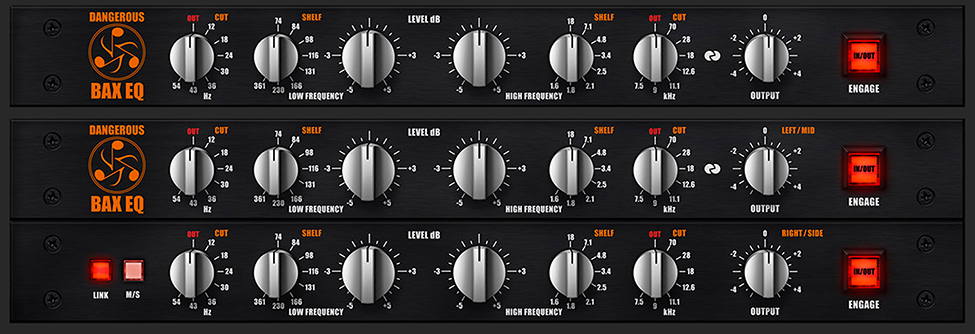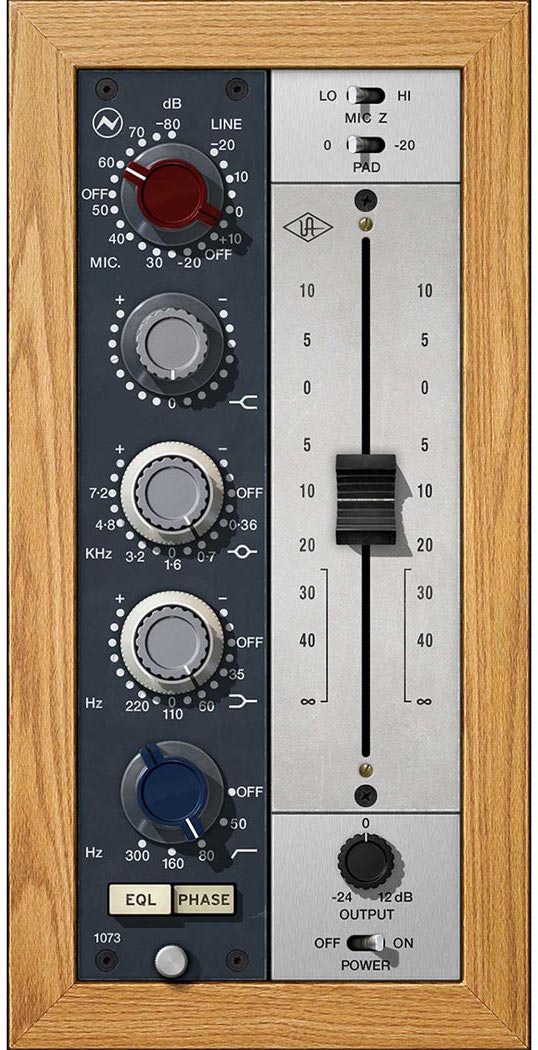6 of the Best Analog-Modeled EQs On The Market
Good analog-modeled plugins are always fun to use because they emulate many of the peculiarities found in analog gear. The linear and predictable processing that stock digital plugins often provide can sound sterile by comparison and lack some of the “musicality” inherent in analog equipment.
Even if you can afford to populate your studio with tons of analog goodies, there are only so many channels of outboard color that you can reasonably fill your studio with. Fortunately, many of the most interesting units available today also come in the form of high-quality analog-modeled plugins. This defeats the need for space, cable management, and complex outboard routing—not to mention the expense of analog gear.
Digital emulations used to not sound much like “the real thing.” However, today’s analog-modeling technology has advanced so far that sometimes it’s impossible to tell the difference.
Of course, not all emulations are created equal. Some companies are trying to model analog gear, and other companies are actually succeeding, with flying colors, in doing so. Some of the most notable companies include Plugin Alliance, Universal Audio, Slate Digital, and Kush Audio.
The EQs in this list differ significantly in their design and their sound, making each entry a unique flavor of its own. While many digital EQs can end up sounding quite similar to one another, all the EQs on this list aim to capture the intricacies, character—and welcome limitations—of their analog counterparts, meaning that each one produces a distinct tone that’s useful in a variety of situations.
Any list like this is going to be incomplete. So rather than providing an exhaustive list this time around, I’ll be walking you through six of my very favorite analog-modeled EQs, each of which is useful in its own way. I’ve found these to be some of the most surprisingly “analog-sounding” EQ plugins available. Disagree? Have some of your own favorites I missed? Tell all about them in the comments below.
Maag Audio EQ4 from Plugin Alliance
The Maag Audio EQ4 is a six-band equalizer that’s extremely transparent, perfect for adding top-end presence, and great at maintaining a “natural” sound. It puts an emphasis on musicality and is a go-to tool for adding “air” to vocals, guitars, and synths. This EQ also provides low phase shift across the board.
You have control over six bands, with the crown jewel being the coveted Air band that allows you to apply a high shelf boost to 2.5k, 5k, 10k, 20k or even way up at 40 kHz. The Maag Audio EQ4 tends to avoid the harshness and hiss that sometimes comes along with applying a high shelf boost using other EQs; this makes it an excellent option for brightening up masters.
The EQ4 isn’t going to provide you with the surgical processing found in many digital EQs, but it’s a tremendous tone-sculpting tool. If you’re looking to bring out the top end of a sound, the Maag Audio EQ4 is a reliable choice.
Pultec EQP-1A from Universal Audio (and others)
The Pultec EQP-1A feels like it’s tailor-made for buses. Its low and high shelves are the stuff of legend. They have been used on countless records and because of how familiar their response is with listeners, they have a knack for just sounding “right”.
You’re also able to simultaneously boost and cut selected frequencies using the Pultec. This is a quirky design that doesn’t seem to make much sense at first. What’s the point of boosting a frequency and then cutting it?
Well, the Boost control provides a bit more gain than the Attenuation control provides cut, and the two knobs affect slightly different frequencies, so the way they interact with one another can produce unique, musical results—potentially adding a bit of a dip or bump directly above the low-frequency shelf you’ve selected. Digital EQs today often try to mimic this behavior, but the idiosyncratic response of the EQP has been heard on generations upon generations of great mixes.
This EQ has an unusual design, with three bands—one for the low end, and two for the high end. The low band offers a low shelf with boost and attenuation controls, and as mentioned, you’re able to create a resonant shelf when you turn both knobs up at the same time. There’s a high band that provides a fairly wide bell boost that can be applied to one of seven frequencies, and a bandwidth knob that goes along with it. Then, there’s a third band that also controls the highs, but with only attenuation available, for smoothing out the top end.
While you don’t need to fully understand how a Pultec EQP-1A works to get great results, taking a look at its user manual isn’t a bad idea. It takes a minute to wrap your head around the plugin’s design, but it’s smooth sailing once you figure it out.
Dangerous Music BAX EQ from Plugin Alliance
The Dangerous Music BAX EQ is a powerful mastering-grade EQ that uses Baxandall curves. Traditional shelving EQs apply a steep filter slope immediately above or below the frequency that you set, with a fixed boost or cut beyond that point. Baxandall curves, on the other hand, have a much smoother and gently rising slope.
The difference may be subtle in small doses, but it’s an entirely different type of curve. Many mixing and mastering engineers reach for a Baxandall EQ when applying stereo bus processing, due to its smooth, forgiving and natural sound.
With the BAX EQ, You’re able to apply a low cut and high cut filter in addition to the Baxandall low shelf and high shelf filters, helping to ensure the EQ doesn’t get out of hand at the extreme lows or highs.
For all that’s going on under the hood, this is a relatively simple EQ to use. The “Master” version of this plugin from both Plugin Alliance and Universal Audio offers up a Mid/Side mode that allows you to process the center and sides of your stereo image independent of one another.
The amount of gain (+/-5 dB) that the BAX EQ lets you to boost its shelves is somewhat limited. But generally, I find that if a BAX EQ doesn’t provide enough gain reduction or amplification when mastering, there’s likely a mix issue that needs to be addressed. This device has a relaxed character and allows you to easily achieve both fat low-end and bright top-end, particularly at the mastering stage.
Manley Massive Passive from Universal Audio (and others)
The Manley Massive Passive is an ultra-high-end tube EQ intended for mixing and mastering with a natural and open sound. It has unique filter curves, bands that overlap with one another, subtle tube amp distortion when desired, and transformer/inductor hysteresis.
Regardless of how you manipulate the Manley Massive Passive, the results will sound subtly different from almost any other EQ and, in general, consistently pleasing. Due to its unique design, it’s almost impossible to push this EQ too far or get it to sound bad.
The bands on this EQ work a bit differently from other EQs, but don’t take very long to learn how to use. For example, there’s a boost/cut switch that toggles the gain control into different modes. The bandwidth knobs shift between a standard shelf and a shelf with a reciprocal cut—useful for boosting low-end while cutting low-mids or boosting high-end while cutting mid-highs. Most of the other features like the low-pass filters, high-pass filters, and stereo link switch work as expected.
The Manley Massive Passive’s bands all work in parallel, functioning just like the hardware does. This allows you to crank the gain controls up to “11” without much risk of harshness. The mixing version of this EQ provides gain knobs up to 20 dB, while the mastering version offers a smaller 10 dB of gain.
Kush Audio Clariphonic Parallel Mastering EQ
The Clariphonic Parallel Mastering EQ allows you to add focus, clarity, presence, sheen, shimmer, and silk to your audio signal. It’s great for bringing out the mid-range and top end of a mix. When used with a heavy hand, you can overdo the effect, but when used in moderation, this unit can really make a mix come to life.
Parallel EQs aren’t a common mixing tool, and you don’t tend to hear very much about them. Perhaps you didn’t even know parallel EQs existed. The basic concept is that you EQ a duplicate of the original signal, and mix the processed duplicate back into the original. This helps preserve the integrity of the original signal, while your mix also benefits from the adjustments made to the EQ’d signal.
Even though this EQ is marketed as a mastering tool, you can still use the Clariphonic Parallel Mastering EQ on vocals, acoustic guitar, and bass tracks. It allows you to process audio in dual mono, stereo, or mid-side mode, further enhancing its usefulness, and making it easy to get a bit more surgical with a dull mix if necessary.
Neve 1073 from Universal Audio (and others)
The Neve 1073 is a very famous pre-amp that just so happens to have an incredibly useful and iconic EQ built-in.
It’s an EQ that is exceptionally colorful and is one of my favorite EQs to use when trying to capture a 1970s vibe. It works especially well when mixing rock records, though there are plenty of pop mixers who love it on vocals as well.
This isn’t the type of EQ I’d use when mastering, as it uses such broad strokes, but it’s great for mixing.
The UAD version of the plugin can be used for the 1073 EQ while mixing, or it can be used as a mic pre-amp when tracking with a Universal Audio Interface like the Apollo x8.
The plugin has a big, fat, warm sound. Driving the pre-amp will saturate your input audio, which can help to increase perceived loudness and “thicken” the material you’re working on. Once you’ve sufficiently saturated, distorted, and/or clipped your signal, you’re able to shape the tone further using the EQ section.
The 1073 offers a high-pass, low-shelf, bell, and high-shelf filter. To manipulate the set frequency of the low-shelf and bell filter, you need to adjust the outer ring of their knobs; the inside part of their knobs adjusts gain. Other than that, there aren’t too many peculiar design elements that come along with this EQ—it just produces quality results fast and with minimal fuss.
Summing it Up
The fun thing about analog equipment is that it doesn’t always do just what it was built to do. Often times, the components that make up an analog unit can be exploited in creative ways to produce impressive results.
The slight unpredictability that comes along with using analog-modeled EQs is what makes using them fun. Mixing doesn’t always need to be planned and calculated. Sometimes, diving into the unknown is exactly what a mix calls for.
All of the EQs on this list are available to demo from one company or another, so feel free to test these analog-modeled plugins yourself. If you’d like to nominate your own favorites, by all means, do! Consider the conversation started, and tell us about your favorites.
Charles Hoffman is a Mixing and Mastering Engineer at Black Ghost Audio. After graduating from the University of Manitoba with an English degree, Charles completed his education at Icon Collective in Los Angeles, CA.
Please note: When you buy products through links on this page, we may earn an affiliate commission.












